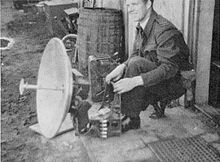Berlin (radar)
The FuG 240 "Berlin" was a radar device used by the German Air Force during World War II . It was built by Telefunken and used from April 1945. It was the most modern German radar device for interceptors and already had all the essential features of today's models. By the end of the war, only 25 copies could be made.
history
The FuG 240 only used a small parabolic antenna instead of the large directional antenna that was still used in the Lichtenstein radar. This could be installed aerodynamically more favorably behind a plywood cladding in the nose of an aircraft. This resulted in an airspeed higher by 50 km / h.
The FuG 240 was used in the Ju 88 G -6 night fighter aircraft . This new small radar device was made possible by loot from shot down British aircraft with Rotterdam devices . The magnetrons used were previously unknown in Germany. The very short wavelengths that this made possible now allowed much more compact devices with more transmission power and greater range. While "Lichtenstein" was still working with a wavelength of 60 cm, "Berlin" broadcast on 9 cm. This made it possible to reduce the size of the antenna by a factor of 7.
At the end of the war, "Berlin" devices were also installed on a few submarines , speedboats and on the heavy cruiser Prinz Eugen . The further development FuG 244 "Bremen" was no longer used.
gallery
Technical specifications
- Transmission power: 15 kW ( pulse power )
- Search angle: +/- 55 °
- Antenna size: 70 cm
- Frequency: 3,250-3,330 MHz
- Range: 500–9,000 m
See also
- Radio measuring devices - overview of German radar devices in World War II
Web links
- Berlin FuG 224 (= FuMO 81) detailed German description at www.cdvandt.org
- Sample images of the Berlin device at www.cdvandt.org, from p. 92 in the PDF document
- The Century of Radar on www.100-jahre-radar.de (pdf, engl.)
- Radar in WW II, compiled by Larry Belmont ( Memento October 10, 2009 in the Internet Archive )
Individual evidence
- ↑ MARINE-RUNDSCHAU year 1968, issue 6, article: The revolutionization of naval war by radio measurement . Verlag Mittler & Sohn, Herford, p. 425


